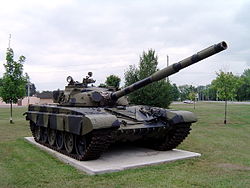 Vehicles on display inside the museum | |
 | |
| Established | 1970 |
|---|---|
| Location | CFB Borden, Borden, Ontario, Canada |
| Type | Military museum |
| Website | https://cfmws.ca/borden/facilities/borden-military-museum |
Base Borden Military Museum is a military museum located on the grounds of CFB Borden, in Borden, Ontario, Canada. Combining four separate museums, it has numerous items, equipment and vehicles from all eras of Canadian military history, including a large number of historic armored vehicles and aircraft displayed outside in the Major-General F. F. Worthington Memorial Park and around the base.
Contents
The museum is located just south of Angus, Ontario. The museum, which combines all the separate museums at the base, was established in 1970. [1] [ failed verification ] These included the Worthington Museum and the RCEME Corps Museum. [2] [3]
In June 2007 a new main building for the museum complex was opened, with a large hangar for the display of historic military vehicles.[ citation needed ] The museum complex consists of several buildings and a memorial park. It also operates an annex for aviation in Hangar 11 elsewhere on the base. [1]
Hangar 11 was reopened in April 2024 after a renovation. [4]
The Museum is affiliated with: CMA, CHIN, OMMC and Virtual Museum of Canada.












